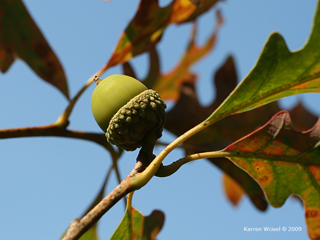Quercus abla, White Oak
/
Jade Wheeler
09/12/2020
Quercus alba[1]
“Quercus alba” also known as the white oak, it is a well-known oak tree usually identified by its white or gray flakey bark and its deeply lobed leaves with a glossy appearance. In the fall the leaves will turn a beautiful orange or red. In the winter they will senesce and become a brown color. When new leaves emerge, they have a white color making them almost look like flowers. The white oak is a monecious plant with pendulous male catkins that emerge at the same time as the leaves (Tree topics). The female flowers are also on the same tree. Acorns of the White oak require only 1 season to mature. In mid-July, the caps cover nearly the entire acorn. By mid-August, the cap covers less than half of the acorn. By early October, most of the acorns will be on the ground. In most cases, the cap will have separated from the rest of the acorn, but in cases where they are still together, the cap will cover 1/3 or less of the acorn (Tree topic). The white oak is in the Fagaceae or beech family. The tree’s native habitat ranges all through the eastern part of North America. It is found from southwestern Maine and extreme southern Quebec, west to southern Ontario, central Michigan, to southeastern Minnesota; south to western Iowa, eastern Kansas, Oklahoma, and Texas; east to northern Florida and Georgia. The tree is generally absent in the high Appalachians, in the Delta region of the lower Mississippi, and in the coastal areas of Texas and Louisiana (Rogers). It is used for many constructional purposes as well. Some places will use the white oak for barrels because of its tyloses. White oak is sometimes planted as an ornamental tree because of its broad round crown, dense foliage (Rogers). The white oak is one of the well-used oak for lumber work. It is used in building houses, used for flooring, countertop, and many other aspects. It is found on sandy plains, gravelly ridges, rich uplands, coves, and well-drained loamy soils. Growth is good on all but the driest, shallowest soils (Minckler). They are very common in east Texas and are used in many landscapes for shade and design. With them being a large tree, they can be used for many other things as well, such as tree house areas or swings. With sturdy large branches you can tie a swing to the branches or even build a small tree house in them for your kids.
Works Cited
Minckler, Leon S. 1965. White oak (Quercus alba L.). In Silvics of forest trees of the United States. p. 632-637. H. A. Fowells, comp. U.S. Department of Agriculture, Agriculture Handbook 271. Washington, DC.
Roger, Robert. White Oak. www.srs.fs.usda.gov/pubs/misc/ag_654/volume_2/quercus/alba.htm.
Upon initially opening the document, I was already excited to read because it looks very neatly presented.






